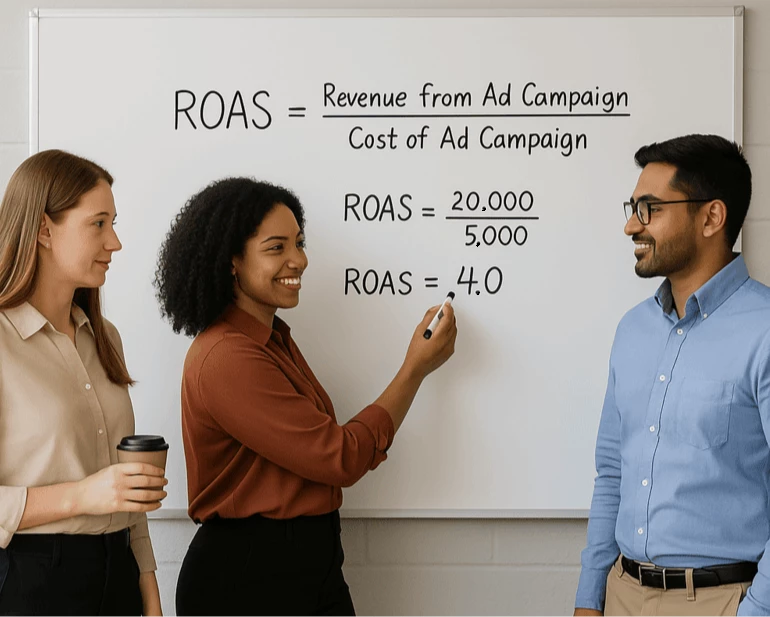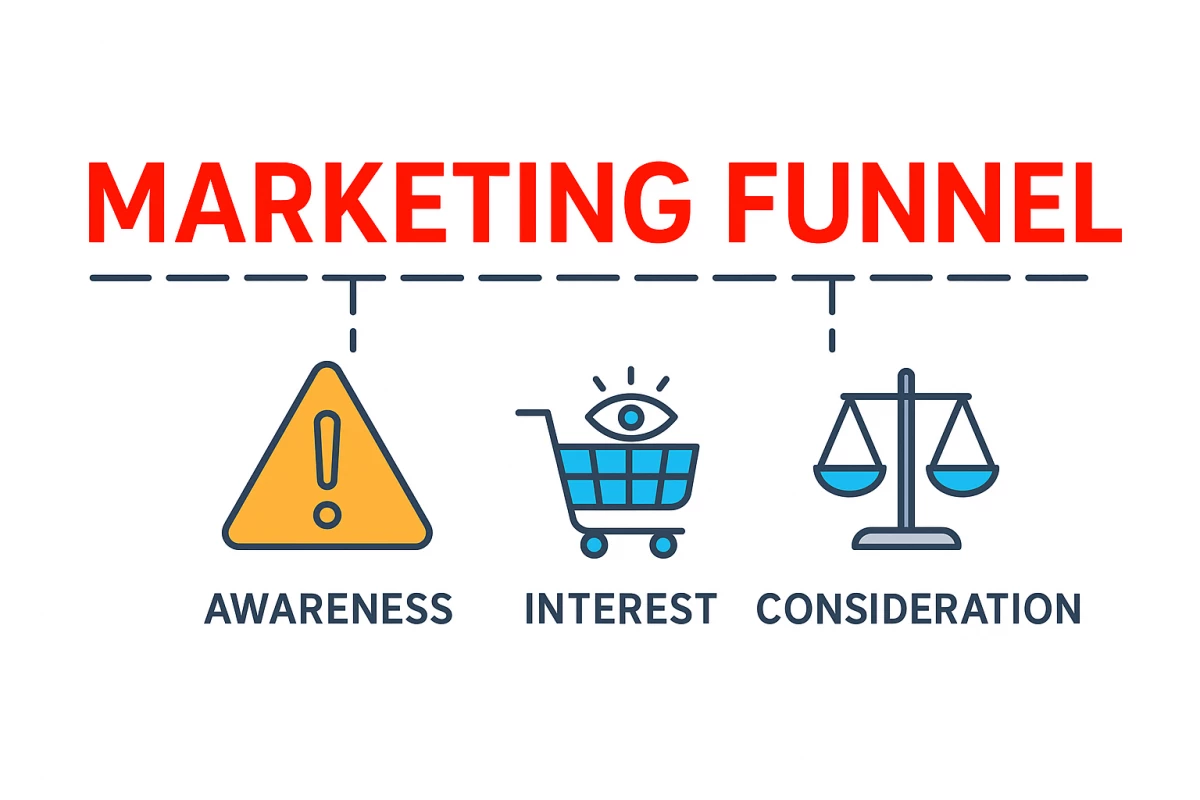Evaluating Return on Ad Spend (ROAS) in Ad Performance
ROAS measures the revenue generated for every dollar you spend on advertising. It demonstrates how much revenue is earned from advertising compared to the cost of the ad campaign.
Return on Ad Spend (ROAS) is a KPI used by marketers to evaluate the effectiveness of their advertising campaign. It’s important to know the precise definition and importance of ROAS and its calculation, appropriate usage, limitations, and comparisons with other performance metrics.
How Do I Calculate ROAS
The result of the formula for ROAS provides a clear picture of campaign profitability. When used correctly, it can help you allocate your budget more effectively, ensuring you invest in campaigns that generate the best returns.
ROAS calculation can be shared as a ratio or a percentage. If presenting the ratio, it represents the return on investment for each dollar spent. Using a percentage will provide a larger assessment of the ad campaign's profitability.
For instance, your Q1 ad campaign cost $50,000, and you acquired $200,000 in revenue attributed directly to the campaign. $200,000 / $50,000 gives you a ratio of 4:1 or a percentage result of 400%.
To calculate your ROAS, you’ll need to accurately track ad spend and be able to correctly attribute revenue. You’ll need to utilize analytics tools and attribution models. If you are being very precise, you will also need to consider external factors that may influence sales, like separate events, PR, or sales tactics used during the campaign.

What is a Good ROAS?
Many factors influence what an acceptable ROAS looks like. A good ROAS depends on your industry, business model, margins, and campaign goals. Consider industry benchmarks and variability across different sectors.
Leading influencers of a good ROAS:
- Profit margins: A low-margin product might require a high ROAS to break even, while a high-margin product can afford a lower ROAS.
- Customer Lifetime Value (CLV): If your CLV is high, you might accept a lower initial ROAS (even below 1:1) to acquire a customer profitably over time.
- Channel and funnel position: Top-of-funnel brand awareness campaigns usually have a lower ROAS than bottom-of-funnel retargeting efforts.
A ROAS of 4:1 is considered a good outcome, assuming your margins support it. It shows that you generated $4 in revenue for every $1 spent on advertising. Anything higher is great, taking into account all the factors above.
A high ROAS isn’t always positive if you’re underspending and missing volume. And low ROAS isn’t always negative if you’re acquiring customers with a high lifetime value. A very high ROAS, like 10:1, may suggest under-investment, meaning you could scale the campaign and gain more total revenue even if ROAS drops slightly. A high ROAS without sales lift, profit, or CLV growth could be misleading.
Best Use of ROAS in Marketing
Advertisers use return on ad spend as a KPI to quickly assess a campaign's effectiveness and guide budget allocation for future campaigns.
From a programmatic marketing perspective, ROAS optimizes ad spend by targeting the most profitable audiences and adjusting bids in real-time to maximize returns.
ROAS can be pivotal in programmatic because it can actively lead bid strategies and audience targeting to be more efficient by homing in on actual revenue signals instead of higher up actions like clicks or views.
Continuously monitoring ROAS allows advertisers and their media buying team to make decisions to optimize their campaigns and improve overall performance. However, in programmatic advertising, marketers sometimes misinterpret ROAS by not accounting for all costs involved, such as platform fees and creative design costs. This can result in an inflated view of campaign performance.
Limitations of Return on Ad Spend
There are limitations to using ROAS as a performance metric. When used in isolation, ROAS has the potential to be misinterpreted. Brands may overlook long-term brand building, which is vital to their business's growth, and may show up as lower ROAS. Ignoring overall profitability by not accounting for all costs can also provide false results.
ROAS does not account for other business expenses, such as overhead costs, and may not reflect a campaign's true profitability. It also focuses on immediate returns, potentially overlooking long-term customer value. This can lead to misallocation of budget and missed opportunities for building brand loyalty.
In programmatic advertising, ROAS can be limited by attribution challenges, such as accurately tracking conversions across multiple channels. It may also struggle to differentiate between causality and correlation.
Return on ad spend as a KPI is only as strong as your weakest link. A misaligned media buy, poor targeting, low-quality creative, or placement on the wrong ad channels can all drag down performance.
Consider Marketing Efficiency Ratio (MER) to include all costs — creative production, platform fees, tools, agency retainers, etc., not just media spend (Total Revenue /Total Marketing Spend, all-in).
Choosing the Right KPI: Is it always ROAS?
Different KPIs work better for different ad channels, funnel levels, audiences, and journey phases. Be sure to use the right ad spend analysis for your situation.
For brand ads, metrics like brand awareness or lift, engagement, and reach are more appropriate. ROAS, conversion rate, and cost per acquisition (CPA) are key for traditional ad performance. Funnel-level KPIs include impressions and click-through rate (CTR) for awareness, engagement metrics for consideration, and conversion rate for decision-level activity.
In programmatic advertising strategies, brand ads should focus on viewability and engagement metrics. Prioritize ROAS, CPA, and conversion rate for performance ads. Funnel-level KPIs can include programmatic-specific metrics like bid win rate and audience reach.
Review a limited list of other KPIs compared to ROAS:
The differences between ROAS and Return on Investment (ROI)
- ROI considers total costs and overall profitability.
- ROAS focuses solely on revenue generated per dollar spent on advertising.
- Scenarios where each metric is most applicable.
ROAS vs. Sales Lift
- Sales lift measures the increase in sales attributed to an advertising campaign.
- Differences in focus: incremental sales vs. revenue-to-cost ratio.
- Complementary use of both metrics for comprehensive analysis.
Metrics for Measuring Ad Performance
- For a holistic view, combine ROAS with metrics like ROI, customer acquisition cost (CAC), and customer lifetime value (CLV).
- Align metrics with business objectives.
ROAS, Advertising, and Smart Media Buying
If your media plan doesn’t align with where your ideal customer spends time, your ROAS will suffer, even with great creative.
Different advertising channels yield different average ROAS (e.g., search often performs higher than display), so expectations should be adjusted accordingly. Make sure you are set with each channel’s standard benchmarks.
Your chosen attribution model matters. Last-click attribution can distort ROAS. Consider multi-touch attribution to see which channels influence conversions, not just close them.
To optimize your return on ad spend, ensure you have these six strategies in place.
- Focus on high-performing channels and designate your ad spend based on the chosen channels to optimize your media buying strategy.
- Utilize real-time bidding to optimize programmatic ad spend and target the best audiences.
- Test and optimize ad creatives to improve engagement and conversion rates.
- Implement dynamic creative optimization to tailor programmatic ads to individual user preferences.
- Use data-focused insights to select the most effective channels for your target audience.
- Leverage programmatic platforms to automate and refine channel selection based on performance data.
Ad Design and Messaging Impact ROAS More Than You Think
ROAS is most effective for direct response advertising, such as e-commerce campaigns, where the goal is to drive immediate sales. It is often not as effective for brand awareness campaigns intending to build long-term customer relationships and take time to see direct results.
Programmatic display and search ads are well-suited for ROAS measurement, as they can be optimized in real-time based on advertising performance metrics. Social media ads for lead generation can also benefit from ROAS tracking to refine targeting and creative strategies.
If your message resonates with your audience, they'll click and convert at higher rates, improving ROAS. A message that works on Instagram Stories might flop on YouTube pre-roll. Ad creative needs to match the medium. Test, test, test. Minor tweaks to CTAs, headlines, or visuals can improve ROAS. Don’t let one version define your campaign’s success.

Channel Placement Should Be Aligned to Intent and Funnel Stage
Channels like CTV, display, and radio are used for top-of-funnel or awareness tactics and typically have lower ROAS but are crucial for priming performance later. Expect lower returns here.
Channels like paid search, retargeting, and shopping ads used for consideration and conversion or mid-to-bottom-funnel tactics typically show higher ROAS. They should be evaluated based on this strategy.
Programmatic and paid social platforms allow for audience-based buys. If your data is insufficient or too broad, you’ll waste spend and dilute ROAS.
While ROAS is a valuable metric for evaluating advertising efficiency, it should be used alongside other performance indicators to understand marketing effectiveness comprehensively.
As you’ve learned, many factors must be considered when tracking and reporting on ROAS. All properties should be evaluated to decide the best KPI to measure your campaign objectives and overall marketing goals.
While the calculation for Return on Ad Spend may be simple, the story the results tell may not be the best KPI for your industry, budget, goals, ad creative, channels, or audience.





